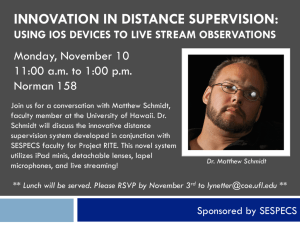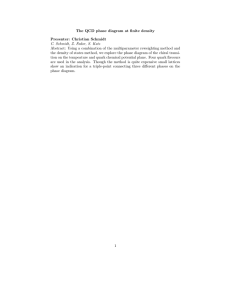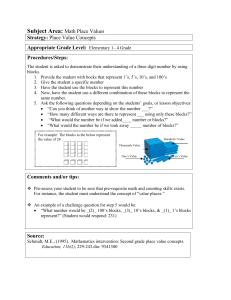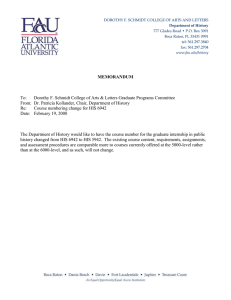On the Effect of Immediate Feedback
advertisement
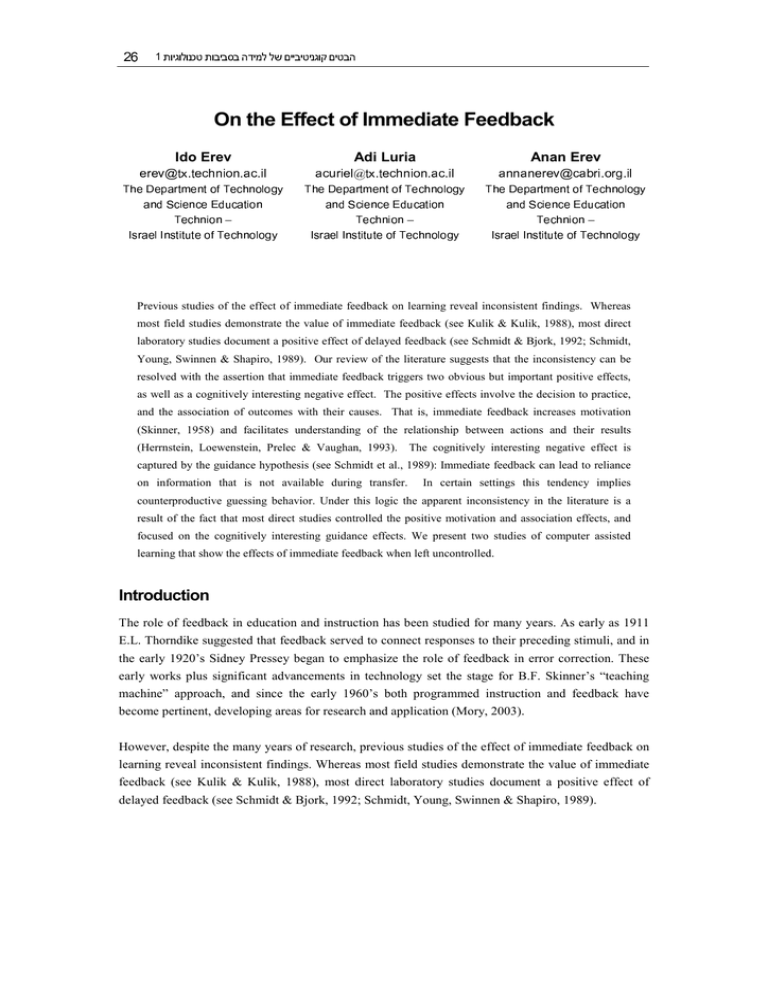
On the Effect of Immediate Feedback Ido Erev ! $ % & ' & ) - " ) 4 * 5 + , 0 ; * ) & 1 : - ; & 6 - - & + & 6 $ : ! ( Adi Luria ! + 8 % + . / & 6 . . $ 7 - & + 0 0 # & 4 0 8 - / 0 % - ) + . 6 . 1 . 2 3 $ % & ' - & ) - ( ) 4 * 5 & + $ 0 % - . 1 . 2 3 : ; * ) & 1 : - ; & 6 8 % + . / & 6 . . $ 7 - & # + 0 0 + - - & + & 6 Anan Erev ! , 0 9 $ " @ & 4 0 8 - / 0 % - ) + . 6 . 1 . 2 3 $ % & ' - & ) - ( ) 4 5 & % - . 1 . 2 3 : ; * ) & 1 : - ; , & 6 8 + 0 0 + - - & + & 6 $ 0 + 0 9 $ * % + / & 6 . . & 4 0 8 - / $ 7 - & . 0 % - ) + . 6 . 1 . 2 3 - 9 $ & 0 % - . 1 . 2 3 Previous studies of the effect of immediate feedback on learning reveal inconsistent findings. Whereas most field studies demonstrate the value of immediate feedback (see Kulik & Kulik, 1988), most direct laboratory studies document a positive effect of delayed feedback (see Schmidt & Bjork, 1992; Schmidt, Young, Swinnen & Shapiro, 1989). Our review of the literature suggests that the inconsistency can be resolved with the assertion that immediate feedback triggers two obvious but important positive effects, as well as a cognitively interesting negative effect. The positive effects involve the decision to practice, and the association of outcomes with their causes. That is, immediate feedback increases motivation (Skinner, 1958) and facilitates understanding of the relationship between actions and their results (Herrnstein, Loewenstein, Prelec & Vaughan, 1993). The cognitively interesting negative effect is captured by the guidance hypothesis (see Schmidt et al., 1989): Immediate feedback can lead to reliance on information that is not available during transfer. In certain settings this tendency implies counterproductive guessing behavior. Under this logic the apparent inconsistency in the literature is a result of the fact that most direct studies controlled the positive motivation and association effects, and focused on the cognitively interesting guidance effects. We present two studies of computer assisted learning that show the effects of immediate feedback when left uncontrolled. Introduction The role of feedback in education and instruction has been studied for many years. As early as 1911 E.L. Thorndike suggested that feedback served to connect responses to their preceding stimuli, and in the early 1920’s Sidney Pressey began to emphasize the role of feedback in error correction. These early works plus significant advancements in technology set the stage for B.F. Skinner’s “teaching machine” approach, and since the early 1960’s both programmed instruction and feedback have become pertinent, developing areas for research and application (Mory, 2003). However, despite the many years of research, previous studies of the effect of immediate feedback on learning reveal inconsistent findings. Whereas most field studies demonstrate the value of immediate feedback (see Kulik & Kulik, 1988), most direct laboratory studies document a positive effect of delayed feedback (see Schmidt & Bjork, 1992; Schmidt, Young, Swinnen & Shapiro, 1989). : 4 . 7 * & 4 6 8 * 6 ) - ) - 7 * & The current research attempts to shed light on these results. Our review of the literature suggests that the inconsistency can be resolved with the assertion that immediate feedback triggers two obvious but important positive effects, as well as a cognitively interesting negative effect. The positive effects involve the decision to practice, and the association of outcomes with their causes. That is, immediate feedback increases motivation (Skinner, 1958) and facilitates understanding of the relationship between actions and their results (Herrnstein, Loewenstein, Prelec & Vaughan, 1993). The cognitively interesting negative effect is captured by the guidance hypothesis (see Schmidt et al., 1989): Immediate feedback can lead to reliance on information that is not available during transfer. In certain settings this tendency implies counterproductive guessing behavior. Generally speaking, we suggest that the negative effects of immediate feedback were predominantly demonstrated in studies in which at least one of (the boring) positive effects of immediate feedback had been "controlled out." In addition, we hypothesize that the boring positive effects of immediate feedback tend to be larger than the interesting negative effects. Thus, when the positive effects are not controlled, the total effect of immediate feedback is likely to be positive. This hypothesis is evaluated in two studies. Study 1 focuses on the role of the association effect, and Study 2 focuses on the motivation effect. Study 1 In their classic study, Schmidt, Young, Swinnen & Shapiro (1989) compared the effects of several 'knowledge of results' intervals on performance in a ballistic timing task. Subjects were required to move a slide between specified target zones (including reversal of direction) and maintain a performance time as close to 550 ms as possible. Feedback was provided either after 1 trial (meaning KR after every trial), every 5 trials, 10 trials, or 15 trials. After each trail, subjects' constant error for that trail was plotted on a graph of performance against trials, but shown to them only after the appropriate number of trials for their experimental group (1, 5, 10, or 15 trials). All subjects were required to perform 90 trials during the practice phase, and then 25 more trials ("retention phase") without any KR. In addition, subjects returned two days later for a delayed retention test, during which they received no KR. Schmidt et al.'s (1989) results show that during the practice phase, performance decreased as feedback interval increased. That is, subjects in the 1-trial summary (immediate feedback) condition showed the best practice performance. However, the opposite pattern was observed during retention. In the twoday retention test, the participants trained with immediate feedback performed worse than the participants trained with delayed feedback. These and similar results are often used to support the assertion that immediate feedback leads to shallow learning (see Swinnen, Schmidt, Nicholson & Shapiro, 1990; Schmidt & Bjork, 1992). The current analysis leads to very different interpretation of Schmidt et al.’s results. It suggests that the negative guidance effect is interesting, but is likely to be less general than suggested by some of the efforts to apply it to education and E-learning. We hypothesize that the implications of the guidance effect are highly sensitive to the simplified, one-response, experimental procedure implemented by Schmidt et al. in order to control the association effect. Specifically, we contend that a slight modification of the Schmidt et al.’s paradigm, an increase in the number of required responses, is expected to contribute to the relative value of immediate feedback in two ways. First, when the subject is asked to learn more than one response, the association effect is expected to impair the value of delayed feedback. In addition, the assortment of possible responses decreases reliance on preceding response. In order to test this hypothesis we conducted a replication of Schmidt et al. in which the participants were asked to learn four distinct responses. As in the original study, the different responses involved the performance of a simple motor task at a particular speed. The motor task involved two key presses. The different tasks differed with respect to the required time interval between the two presses: It was 300, 600, 900, or 1200 ms. The experiment included two control and two experimental conditions. The two control conditions involved a simplified replication of Schmidt et al. (1989). The participants were asked to learn a single motor response: To press a key twice such that the time between the two keys will be 750ms. The participants received immediate feedback after each choice in the Immediate control condition, and summary feedback in groups of 5 trials, in the Delayed control condition. As in the original study, the experiment included 90 practice trials, a 10 minute retention test, and a 2-day retention test. The two experimental conditions were identical to the control conditions with the exception that the participants were asked to learn four time intervals: 300, 600, 900, or 1200 ms. In each of the trials they received an instruction concerning the required time interval between the two presses. The results in the control conditions show the pattern observed by Schmidt et al. (1989). Immediate feedback facilitated performance during transfer, but impaired performance during retention. The results in the experimental conditions (4 possible response) show a very different pattern. The requirement to consider four tasks had two main effects. First, it impaired performance in the delayed feedback condition. This result demonstrates the association effect. Second, the added tasks decreased the difference between practice and retention in the immediate feedback condition. Overall, the immediate feedback condition lead to much better performance during practice and transfer. Study 2 Most studies of the effect of immediate feedback in computer assisted learning control the effect of the decision to practice by ensuring fixed practice time. In order to evaluate the implication of this research method, we compared two versions of an “electronic notebook” designed to facilitate practice of long division. Version Immediate provided feedback after each step. Version delayed provided delayed feedback for sets of five problems. The participants were elementary school students. They were invited to the laboratory for a 2-hour experiment. During this time they had five opportunities to select between practicing long division, and playing games on the web. The results revealed a motivation effect. The participants practiced : 4 . 7 * & 4 6 8 * 6 ) - ) - 7 * & more in the immediate feedback condition. In addition, the results show that for each level of practice time (when the motivation effect is controlled), the immediate feedback lead to lower performance (more errors). This result is consistent with the guidance hypothesis. However, this negative effect is not observed on the aggregate. Conclusions Previous studies of the effect of immediate feedback on learning appear to lead to contradicting results. The current research highlights a simple and sufficient explanation of this inconsistency. According to this explanation, the inconsistency is a result of the fact that many of the experimental studies controlled the positive effects, and focused on the negative effect of immediate feedback. The current results suggest that this research method might lead to incorrect generalizations. The fact that the positive effects of immediate feedback are less interesting does not mean that they are less important. References Herrnstein, R. J., Loewenstein, G. F., Prelec, D., & Vaughan, W., Jr. (1993). Utility maximization and melioration: internalities in individual choice. Journal of Behavioral Decision Making, 6, 149– 185. Kulik, J.A. & Kulik, C.C. (1988). Timing of feedback and verbal learning. Review of Educational Research,58(1), 79-97. Mory, E.H. (2003). Feedback Research Revisited. In D.H. Jonassen (ed.), Handbook of research for educational communications and technology, 2cnd Edition (pp. 745-783). Mahwah, NJ: Lawrence Erlbaum. Schmidt, R.A. & Bjork, R.A. (1992). New Conceptualizations of practice: Common principles in three paradigms suggest new concepts for training. Psychological Science, 3(4), 207-217. Schmidt, R.A., Young, D.E., Swinnen, S. & Shapiro, D.C. (1989). Summary knowledge of results for skill acquisition: Support for the guidance hypothesis. Journal of Experimental Psychology: Learning, Memory, and Cognition, 15(2), 352-359. Skinner, B.F. (1958). Teaching Machines. Science, 128 (3330), 969-977. Swinnen, S.P., Schmidt, R.A., Nicholson, D.E. & Shapiro, D.C. (1990). Information feedback for skill acquisition: Instantaneous knowledge of results degrades learning. Journal of Experimental Psychology: Learning, Memory and Cognition, 16(4), 706-716.
